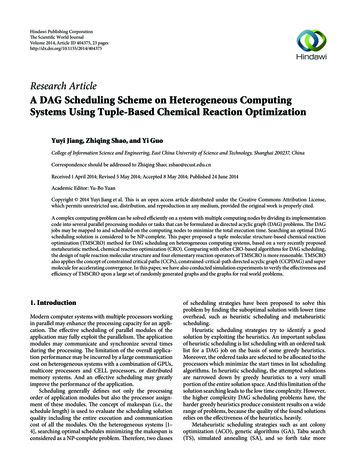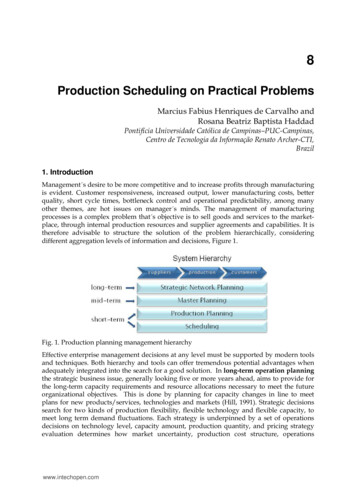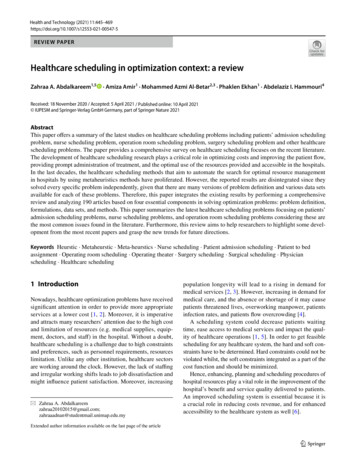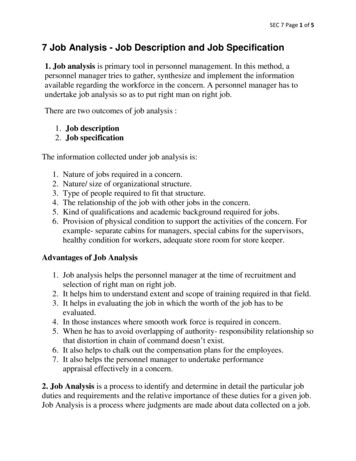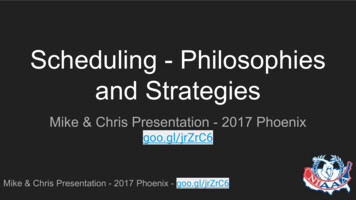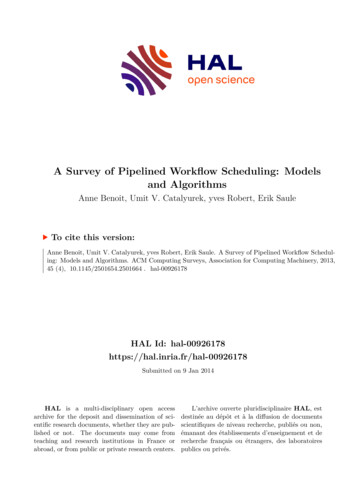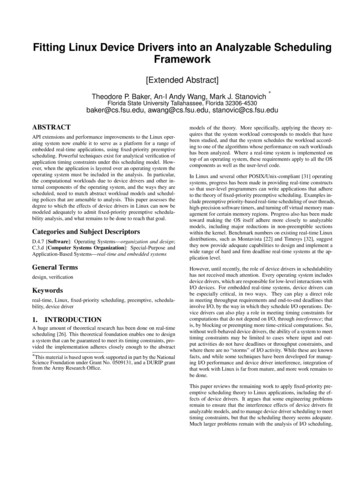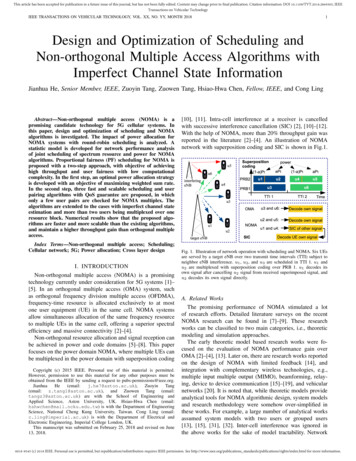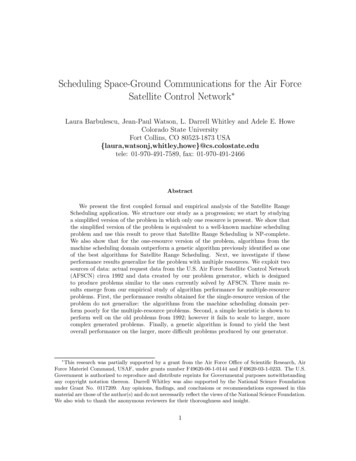
Transcription
Improving Performance of Job SchedulingAlgorithms in Cloud Computing EnvironmentSiddhardha TagirisaDepartment of Computer Science and EngineeringNational Institute of Technology RourkelaRourkela-769 008, Odisha, IndiaMay 2015
Improving Performance of Job SchedulingAlgorithms in Cloud Computing EnvironmentThesis submitted in partial fulfilmentof the requirements for the degree ofBachelor of TechnologyInComputer Science and EngineeringBySiddhardha Tagirisa(111cs0427)Under the supervision ofProf. Pabitra Mohan KhillarNIT RourkelaDepartment of Computer Science and EngineeringNational Institute of Technology RourkelaRourkela-769 008, Orissa, IndiaMay 2015
Department of Computer Science and EngineeringNational Institute of Technology RourkelaRourkela-769008, Odisha, India.CertificateThis is to ensure that the work in the proposition entitled Improving Performance Of JobScheduling Algorithms In Cloud Computing Environment by Siddhardha Tagirisa(111cs0427), is a record of a unique examination work did by him under my watch anddirection in complete satisfaction of the necessities for the grant of the level of Bachelor ofTechnology in the branch of Computer Science and Engineering, National Institute ofTechnology Rourkela. Neither this theory nor any piece of it has been submitted for anydegree or scholastic grant somewhere else.(Professor. Pabitra Mohan Khillar)Professor,CSEDepartment NITRourkela,Odisha
Acknowledgement"I want to express my most profound and sincere appreciation to my task guide, Prof.P.M.Khilar for having confidence in my capacity. His significant bits of knowledgehave helped me complete my project work. The adaptability of work and significantproposals that he has offered me has profoundly empowered me and helped me in thefruitful finish of my venture. I'm paying off debtors to every one of our teachers,classmates and companions at National Institute of Technology Rourkela for theirparticipation and backing too. My full dedication to the work would have not beenconceivable without their gifts and moral support."Siddhardha Tagirisaiv
Authors’ DeclarationI therefore proclaim that all the work contained in this report is my own work unlessgenerally recognized. Likewise, the majority of my work has not been beforehandsubmitted for any scholarly degree. All wellsprings of cited data have beenrecognized by method for fitting references.Siddhardha TagirisaNational Institute of Technology, RourkelaDepartment of Computer Science and EngineeringNational Institute of Technology RourkelaRourkela-769 008, Orissa, IndiaMay 2015v
AbstractScheduling in cloud computing is a system which is utilized to enhance generalexecution time of the job. A good scheduling algorithm can help in load balancing aswell. Scheduling in cloud could be possible in three territories i.e. scheduling jobswithin the virtual machine, Scheduling Virtual Machine on the host, and schedulingjobs to the Virtual Machine.The last scheduling i.e. scheduling the cloudlets to the virtual machine isimplemented on both static and dynamic environments in this thesis. In this the jobsare intelligently scheduled to the best possible virtual machine so that the overallexecution time can be reduced. The outcome proves that the proposed algorithmgives better result in comparison to the already used sequential algorithm.Keywords: Cloud Computing, Scheduling, Load Balancing, Execution TimeImprovement, Algorithmvi
List of Figures& Tables:1.1Cloud Computing Architecture2.1Scheduling Algorithm Comparison3.1Architecture of the present Implemented Algorithm3.2RSDC Flowchartvii
ContentsCertificate ------------------------------------------- iiiAcknowledgement ---------------------------------- ivDeclaration ------------------------------------------- vAbstract ---------------------------------------------- viList of Figures ------------------------------------- ------------ ------- ------------------------------------------------ 10Proposed ------------------------------12Problem ----------------------------13Proposed ---------------------------------13Scheduling Process & -------------13-15Generic ------------------------------------15Techniques for Performance --------15Implementation in Static -----------17-20Implementation in Dynamic ------------235.15.26.Review of related -----------------------7-9Implementation & Simulation ----------------164.14.25.Division of ---------------------------------- 5Proposed 23.33.43.53.63.73.84.Cloud Computing Architecture -------- 3-5Literature ------------------------------------------- ------ Limitations & Future -------------------24Bibliography --------------------------------------25-26viii
Chapter 1Introduction1
Chapter 1Introduction1.1 OverviewCloud computing is the conveyance of figuring administrations over the Internet. Cloudadministrations permit people and organizations to utilize programming and equipmentthat are overseen by outsiders at remote areas. Illustrations of cloud administrationsincorporate online file storage, social networking sites, web-mail, and online businessapplications. The cloud computing model permits access to data and PC assets fromanyplace that a system association is accessible. Cloud computing gives an imparted poolof assets, including information storage room, systems, PC processing power, andparticular corporate and client applications.This administration can tackle numerous issues, for example: Organizations require not to purchase the entire arrangement of servers. They cansimply have administrations from the administration suppliers. It’s easy to handleas many responsibilities are given to cloud provider. It's anything but difficult to handle the same number of obligations are given tocloud supplier. It serves best for the flexible applications (Applications which scale very fastfor example - Facebook)Scheduling the jobs in cloud is an enormous test these days. As though jobs i.e. Cloudlets[1] are booked legitimately then the general execution time can be decreased essentially.Yet, Scheduling is a NP Hard issue so it is vital to apply a few heuristics to get best resultcommonly.2
Cloud computing is the fate of innovation said by different CEO of IT industry. It deals withthe rule that the client must pay agreeing the time for which it is utilizing the assets fromdifferent cloud suppliers. It is no doubt understood that it is not simple to handleextensive assets. It is excessive regarding cash too. So Cloud Computing is the bestresponse to these testing issues.Cloud computing is answer to each issue confronted by numerous Industries which arespecifically or in a roundabout way identified with the Information Technology. This field isbecoming unfathomably the same number of the huge players in the InformationTechnology field like Microsoft, Google, Amazon, SAP are contributing a ton of cash to getenhanced results. They feel that it is the eventual fate of innovation.1.2 Cloud Computing ArchitectureThe Cloud Computing structural scheduling takes a shot at a layered methodology. It has afew on-screen characters like Cloud Consumer, Cloud Provider, Cloud Auditor, CloudBroker, and Cloud Carrier. The mix of every one of these performing artists makes thebuilding design of Cloud Computing [3].It is an exceptionally boundless region that is thereason it is not straightforward how everything is going on but rather this referenceconstruction modelling gives an extraordinary review.Figure1.1: Cloud Computing Architecture(adapted from [1])3
Every on-screen character assume a huge part in the cloud computing working model.They need to have influence to get the job done and fulfil the client [1].The diverse cloud buyers are characterized underneath:Cloud ConsumerCloud Consumers are the performers which expends the administrations gave by the cloudsupplier. They can specifically profit administrations from the suppliers or they can contactthe cloud merchant to get the administrations. They will pay as per the time for which theyhave the administrations from the supplier [4]. They can have distinctive administrationslike SaaS, Paas, Iaas.Cloud ProviderCloud Provider are the performing artists which gives the administrations to thepurchasers. The administrations can be SaaS, PaaS, IaaS. The huge players like google,amazon and so forth have the capacity to give Infrastructure as an administration. Else allother little players are just dealing with giving SaaS or to the some degree PaaS. The CloudProvider likewise charges the cash as per the time for which the administrations arebenefitted by the buyers.In SaaS administration cloud gives the customers to host the administration i.e theproduct at their end (on their assets). This helps the purchasers for not to purchase theassets to run the product. All the security perspectives are additionally taken care of bythe suppliers itself.In PaaS the supplier gives a toolbox to the customers like distinctive IDE or SDK toorder their product and host them on the supplier’s assets [5]. This helps the purchaser tohave a reasonable control over the assets gave by the Cloud Provider.In IaaS the shopper has the aggregate control over the assets gave by the CloudProvider [6]. The low level programming could be possible in IaaS. A percentage of theissues like reaction time, memory use and Disk Access can undoubtedly be tended toutilizing IaaS as an administration.Cloud Auditor4
Cloud Auditor is the performer which deals with all the evaluating and bookkeeping partsof the entire cloud computing situation [7]. In the event that any kind of contentionhappen as far as valuing then it is determined by Cloud Auditor [8].Cloud BrokerCloud Broker is the performer which acts in the middle of the Cloud Consumer and CloudProvider [9]. It helps the clients to pick the proficient and the best cloud supplier. Itassumes an extremely basic part in arranging the arrangement between the supplier andbuyer. In the event that any sort of contention happens then that contention is determinedby the Broker [10].Cloud Broker gives benefits in the accompanying way: Service Inter-mediation It goes about as a middle in givingadministrations from supplier to the customer. Service Aggregation it consolidates the administrations gave eadministrations to the Cloud Consumers. Service Arbitrage it improves the administrations gave by the cloudsupplier and afterward give that as a support of the distinctiveCloud Consumers [11].Cloud CarrierCloud Carrier is simply a medium through which the cloud administrations are given. It isessentially the association supplier for instance airtel, MTNL, BSNL, Vodafone and so forth[12]1.3 Division of ThesisChapter 1 gives the introduction of the theory and brief introduction about the project.Chapter 2 states the Review of related work &Motivation. Chapter 3 briefs the proposedwork. Chapter 4 shows the results & implementation. Chapter 5 gives the conclusion.5
Chapter 2Literature ReviewReview of related workMotivation6
Chapter 2Literature ReviewCloud computing is still another zone of exploration so very little has been done in this fieldas of not long ago. Yet at the same time I have checked on a percentage of the explorationpapers and books to increase some foundation and enhance the officially createdScheduling algorithms till now. This field is developing quickly in the later past so themeasure of examination going on is concentrated.2.1 Review of related workThe analysts of this paper did a study on the effectively created and characterized loadbalancing algorithms [23]. They gave an itemized diagram of the effectively characterizedload balancing algorithms. As we realize that load balancing and scheduling are by onemeans or another related in the field of cloud computing consequently I am characterizingthis paper as a piece of my postulation in the Literature Overview segment. As indicated bythe creators of this paper the load balancing algorithms are of two sorts' i.e. static loadbalancing algorithms and dynamic load balancing algorithms. The static load balancingalgorithms are those which don't alter or change states at runtime yet dynamic loadbalancing algorithms unquestionably do that at run time. As we all realize that the in CloudEnvironment new assets continue including and the general structure of the cloud continuechanging hence static load balancing algorithms don't assume an enormous part. To adaptup to the changing cloud environment the dynamic load balancing algorithms assume ahuge part. This paper additionally characterized the difficulties behind the load balancing incloud environment.A percentage of the fundamental reasons are:Spatial Distribution of the Cloud Nodes As we realize that cloud is a dispersed frameworksubsequently the cloud hubs are spatially appropriated over the topographical areas alongthese lines it turns into an incredible test for the creators of load balancing algorithms tooutline the algorithms remembering the land area of the hubs. The Fault Tolerance mustbe considered.7
Capacity/ Replication to enhance the adaptation to internal failure of the frameworkinformation replication is the route we to go. It is not simple to oversee such an immensemeasure of information. This tremendous measure of information putting away is notsimple and getting it additionally exceptionally troublesome. Thusly, it is essential to dealwith this immense measure of information legitimately to give satisfactory measure ofadministration.Algorithm Complexity If the multifaceted nature of the algorithm is more than the generalturnaround time will most likely increment. Subsequently it is critical for the load balancingalgorithm planners to do a fitting exchange off between the algorithm many-sided qualityand the general unpredictability of the application.Point of Failure If Cloud is utilizing the brought together approach then one purpose ofdisappointment turns into an enormous test subsequently the answer for this issue is thatthe structural scheduling of cloud must get to be decentralized.In this paper the researchers presented another kind of scheduling algorithm which isknown as Meta Scheduling algorithm [24]. In this paper they isolated the jobs into fourunique classes i.e. short tight, short wide, long thin and long wide. With this division theyset the need more to the shorter jobs in such a path, to the point that they don't need totrade off with the longest end time of the bigger job.In the event that we see in an alternate manner this takes a shot at the standard of slagtime. They will slag the longest job to the greatest degree and afterward they will postponeits transforming as needs be. It is critical that starvation does not and that is the primaryobjective of the algorithm thusly they don't defer the job more than there slag time.This exploration work the scientists studied the effectively created and utilized schedulingalgorithms [24]. As we realize that cloud computing uses the effectively characterized andutilized conventions and algorithms yet as a part of a totally diverse way which surely analternate construction modelling hence a hefty portion of these Scheduling algorithmswhich are utilized here are as of now being utilized as a part of operation framework.8
2.1SchedulingAlgorithmComparisonThe above figure demonstrates the distinction among the few Scheduling algorithms. Itrecognizes them on the premise on Scheduling algorithm, scheduling system, Schedulingparameter, scheduling component, discoveries and nature. As we realize that cloudcomputing uses the effectively characterized and utilized conventions and algorithms yetas a part of a totally diverse way which in fact an alternate structural schedulingsubsequently large portions of these Scheduling algorithms which are utilized here are nowbeing utilized as a part of operation framework. As indicated by the creators of this paperthe Scheduling algorithms are of two sorts' i.e. static scheduling algorithm and dynamicScheduling algorithm. The static scheduling algorithms are those which don't alter orchange states at run-time yet dynamic Scheduling algorithms doubtlessly do that at runtime. As we all realize that the in Cloud Environment new assets continue including and thegeneral structure of the cloud continue changing along these lines static load balancingalgorithms don't assume an enormous part. To adapt up to the changing cloudenvironment the static scheduling algorithms assume a huge part. On the off chance thatwe nearly perceive the above characterized Scheduling we ran over a conclusion that eachalgorithm performs better in a predefined situation.The researchers of RSDC Paper did bunches of work and enhanced PPDD (Processor-setPartitioning and Data Distribution Algorithm) algorithm which focuses on scheduling inVMs [17].9
Scheduling parameter of this algorithm is Processing Time. It is utilized to lessen preparing time. It is proficient for load balancing.2.2 Motivation The job Scheduling issue in cloud computing situations is of more significancebecause of its prerequisite in different applications. Efficient Scheduling algorithms as far as turnaround time are vital. The existing algorithms over virtual machines are widely available in the literature However, most of the algorithms are static in nature. Dynamic scheduling of jobs are necessary particularly for real time systemenvironment where the jobs need to be schedules as soon as they arrive to a datacenter. Criteria needs to be distinguished with a specific end goal to calendar the jobsproficiently.2.3 ObjectivePropelled by the prerequisite of enhanced job Scheduling algorithm in cloud environment,the accompanying targets were attempted: To enhance the turnaround time in cloud computing scheduling algorithms To compare with existing algorithms. To implement the proposed algorithm IRSDC using language C and standardsimulator CLOUDSIM.10
Chapter 3Proposed Work11
Chapter 33.1 Proposed WorkScheduling in cloud computing is a procedure which is utilized to enhance the generalexecution time (make compass) of the jobs. A decent Scheduling algorithm can help inburden adjusting also. Scheduling in cloud could be possible in three territories i.e.Scheduling jobs inside the virtual machine, Scheduling Virtual Machine on the host, andScheduling jobs to the Virtual Machine. The last scheduling i.e. scheduling the jobs to thevirtual machine is added to RSDC which takes after scheduling jobs to the virtual machineand actualized.3.2 AssumptionsThe Assumptions behind my proposed procedures are:Static Implementation: The cloud is a private cloud having less number of VMs. At runtime no more cloudlets too assets are included i.e., a static domain. The jobs can be either scheduled prior to VMs or to the VMs.Dynamic Implementation There is no security issues and shortcomings.3.3 Problem DomainThe problem is to schedule or map the cloudlets to the Virtual Machine so thatthe overall turnaround can be slightest. Let there be set of jobs C t1, t2, t3 Let there be an arrangement of Virtual Machines V v1, v2, v3 It is assumed that the environment is static and all the jobs are autonomous. Output that which Cloudlet must be executed to which VM to have the leastTurnaround time.12
3.4 ARCHITECTUREFigure 3.1 Architecture of implemented VMsThe service model is PaaS.H1, H2, .,Hn. Are hosts and V1, V2 Vn are virtual Machines.3.5 Proposed Algorithm Let there be a set of Jobs Let there be a set of VM’s. Scheduling Process (elaborated under this section). Output will be the set of pairs of virtual machine’s and jobs. Execution of jobs in VMs. Turnaround time algorithm.3.6 Scheduling Process & ExecutionThe job scheduling algorithm is given below.1. Take Job Length L & Processing speeds S & Storage Capacity of VMs C &deadlines ofjob D.2. Arrange jobs according to the length.3. Rank Jobs according to deadline & length.4. Higher the deadline higher the rank.5. Lesser the length higher the rank.6. Assign higher rank to VM having high processing speed.13
7. Check whether the job will fit into VM’s storage capacity.8. If not assign it to the VM with storage capacity job length with speed next to thefirst VM we have choose to assign.9. Dead line is more preferable than length.10. After assigning jobs to VM’s we will follow RSDC and will calculate the turnaroundtime for analysing the algorithms.RSDC Flowchart [2]Figure 3.2 RSDC Flowchart14
3.7 Generic TermsThe generic terms which are used in this work as follows: Set of VM’s& number of VMs Set of Jobs: set of cloud lets in the private cloud Waiting Time: time spent in the queue i.e., the difference between arrivaltime and the start time of job Job length: Number of instructions Power of VM: the storage capacity of VM Dead line: time before which jobs must finish their execution Turnaround Time: The time between the end of execution & arrival time. processing time for each VM request time for each process acknowledge time for each processor The final time of processing the Job.3.8 Techniques for Performance EvaluationFor Static Environment Implementation using C language under Linux platform VM Environment. Analysis of AlgorithmsFor Dynamic Environment Implementation using CLOUDSIM15
Chapter 4Implementation &Simulation Results16
Chapter 44.1 Implementation in Static Part17
Results and Analysis18
Summary of Results in Static Environment.1. No. of jobs taken here is 100No. of VM’s481632Existing 1200.1648.6Graphical RepresentationThe above algorithm gives less turnaround time of each cloudlet. By utilizingthis algorithm we can lessen the execution time of jobs. Else job coordinating isa NP hard issue however by utilizing these heuristics we can coordinate in apolynomial many-sided quality.19
2. No. of VM’s taken here is 8No. of 00.1Proposed12002200.132504438Graphical RepresentationThe result shows that the event that differs the quantity of jobs and keep thequantity of virtual machine consistent all things considered additionally ouralgorithm beat’s the existing algorithm.20
4.2 Implementation in Dynamic EnvironmentSummary of results in Dynamic Environment.1. No. of jobs taken here is 100No. of 2.1161400.11200.132800.1648.1Graphical RepresentationThe above algorithm gives the less turnaround time of each cloudlet. Byutilizing this algorithm we can decrease the execution time of jobs. Otherwisejob coordinating is a NP hard issue yet by utilizing these heuristics we cancoordinate in a polynomial multifaceted nature.21
2. No. of VM’s taken here is 8No. of jobsExisting 13644.12005000.14800.1Graphical RepresentationThe result shows that the event that differs the quantity of jobs and keep thequantity of virtual machine consistent all things considered additionally ouralgorithm beat’s the existing algorithm.22
Chapter 5Conclusion23
CHAPTER 55.1 ConclusionMost importantly portrayals, results make you feel that a decent scheduling algorithm cantruly help to diminish the general execution time of the cloudlets which surely will help thecloud suppliers to draw in more clients. Our outcomes above unmistakably demonstrate thatif cloudlets are offered brilliantly to the virtual machines than the general execution can beenhanced effectively.5.2 Limitations & Future ScopeAs this algorithm is tried for static and dynamic situations, this can't be utilized as a part ofdefective and security conditions. Therefore, it is vital to change the algorithm takingthought of broken and security conditions.24
][13][14]M. Armbrust, A. Fox, R. Griffith, A. D. Joseph, R. Katz, A. Konwinski, G. Lee, D. Patterson,A. Rabkin, I. Stoica, et al., “A view of cloud comput- ing,” Communications of the ACM,vol. 53, no. 4, pp. 50–58, 2010.M. Satyanarayanan, P. Bahl, R. Caceres, and N. Davies, “The case for vm- based cloudletsin mobile computing,” Pervasive Computing, IEEE, vol. 8, no. 4, pp. 14–23, 2009.X. Li, X. Jiang, P. Huang, and K. Ye, “Dartcsim: An enhanced user-friendly cloudsimulation system based on cloudsim with better performance,” in Cloud Computingand Intelligent Systems (CCIS), 2012 IEEE 2nd Interna- tional Conference on, vol. 1, pp.392–396, IEEE, 2012.R. Buyya, C. S. Yeo, and S. Venugopal, “Market-oriented cloud computing: Vision, hype,and reality for delivering it services as computing utilities,” in High PerformanceComputing and Communications, 2008. HPCC’08. 10th IEEE International Conference on,pp. 5–13, Ieee, 2008.B. T OGRAPH and Y. R. MORGENS, “Cloud computing,” Communications of the ACM, vol.51, no. 7, 2008.T. Velte, A. Velte, and R. Elsenpeter, Cloud computing, a practical approach. McGrawHill, Inc., 2009.Q. Wang, C. Wang, J. Li, K. Ren, and W. Lou, “Enabling public verifiability and datadynamics for storage security in cloud computing,” in Computer Security–ESORICS 2009,pp. 355–370, Springer, 2009M. Hogan, F. Liu, A. Sokol, and J. Tong, “Nist cloud computing standards roadmap,” NISTSpecial Publication, vol. 35, 2011.S. G. Grivas, T. U. Kumar, and H. Wache, “Cloud broker: Bringing in- telligence into thecloud,” in Cloud Computing (CLOUD), 2010 IEEE 3rd International Conference on, pp.544–545, IEEE, 2010.P. Pawluk, B. Simmons, M. Smit, M. Litoiu, and S. Mankovski, “Introducing stratos: Acloud broker service.” in IEEE CLOUD, pp. 891–898, 2012.D. Villegas, N. Bobroff, I. Rodero, J. Delgado, Y. Liu, A. Devarakonda, L. Fong, S. MasoudSadjadi, and M. Parashar, “Cloud federation in a layered service model,” Journal ofComputer and System Sciences, vol. 78, no. 5, pp. 1330–1344, 2012.L. Carrier, G. Cato, and K. Von Essen, “The backscattering and extinction of visible andinfrared radiation by selected major cloud models,” Applied Optics, vol. 6, no. 7, pp.1209–1216, 1967.R. Buyya, R. Ranjan, and R. N. Calheiros, “Modeling and simulation of scalable cloudcomputing environments and the cloudsim toolkit: Challenges and opportunities,” inHigh Performance Computing & Simulation, 2009. HPCS’09. International Conference on,pp. 1–11, IEEE, 2009.A. Li, X. Yang, S. Kandula, and M. Zhang, “Cloudcmp: comparing public cloud providers,”in Proceedings of the 10th ACM SIGCOMM conference on Internet measurement, pp. 1–14, ACM, 2010. 2325
[15][16][17][18][19][20][21][22][23][24]P. Hofmann and D. Woods, “Cloud computing: the limits of public clouds for businessapplications,” Internet Computing, IEEE, vol. 14, no. 6, pp. 90–93,2010.F. Doelitzscher, A. Sulistio, C. Reich, H. Kuijs, and D. Wolf, “Private cloud for collaborationand e-learning services: from iaas to saas,” Computing, vol. 91, no. 1, pp.23–42,2011.“RSDC (RELIABLE SCHEDULING CLOUD IN CLOUD COMPUTING)” Arash GhorbanniaDelavar,Mahdi Javanmard , Mehrdad Barzegar Shabestari and Marjan Khosravi Talebi“International Journal of Computer Science, Engineering and Applications (IJCSEA) Vol.2,No.3, June 2012”J. Qiu, J. Ekanayake, T. Gunarathne, J. Y. Choi, S.-H. Bae, H. Li, B. Zhang, T.-L. Wu, Y. Ruan,S. Ekanayake, et al., “Hybrid cloud and cluster com- puting paradigms for life scienceapplications,” BMC bioinformatics, vol. 11, no. Suppl 12, p. S3, 2010.P. Salot, A survey of various scheduling algorithm in cloud computing environment,"International Journal of research and engineering Technology (IJRET), ISSN, pp.2319{1163, 2013.M. A Vouk, “Cloud computing–issues, research and implementations,” CIT.Journal ofComputing and Information Technology, vol. 16, no. 4, pp. 235–246, 2008.T. Binz, G. Breiter, F. Leyman, and T. Spatzier, “Portable cloud services using Tosca.” IEEEInternet Computing, vol. 16, no. 3, 2012.R. N. Calheiros, R. Ranjan, A. Beloglazov, C. A. De Rose, and R. Buyya, “Cloudsim: atoolkit for modelling and simulation of cloud computing environments and evaluation ofresource provisioning algorithms,” Software: Practi
Scheduling in cloud computing is a system which is utilized to enhance general execution time of the job. A good scheduling algorithm can help in load balancing as well. Scheduling in cloud could be possible in three territories i.e. scheduling jobs within the virtual machine, Scheduling Virtual Machine on the host, and scheduling
